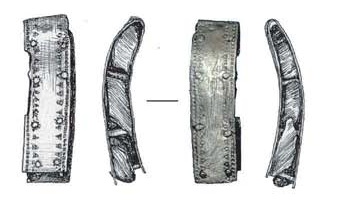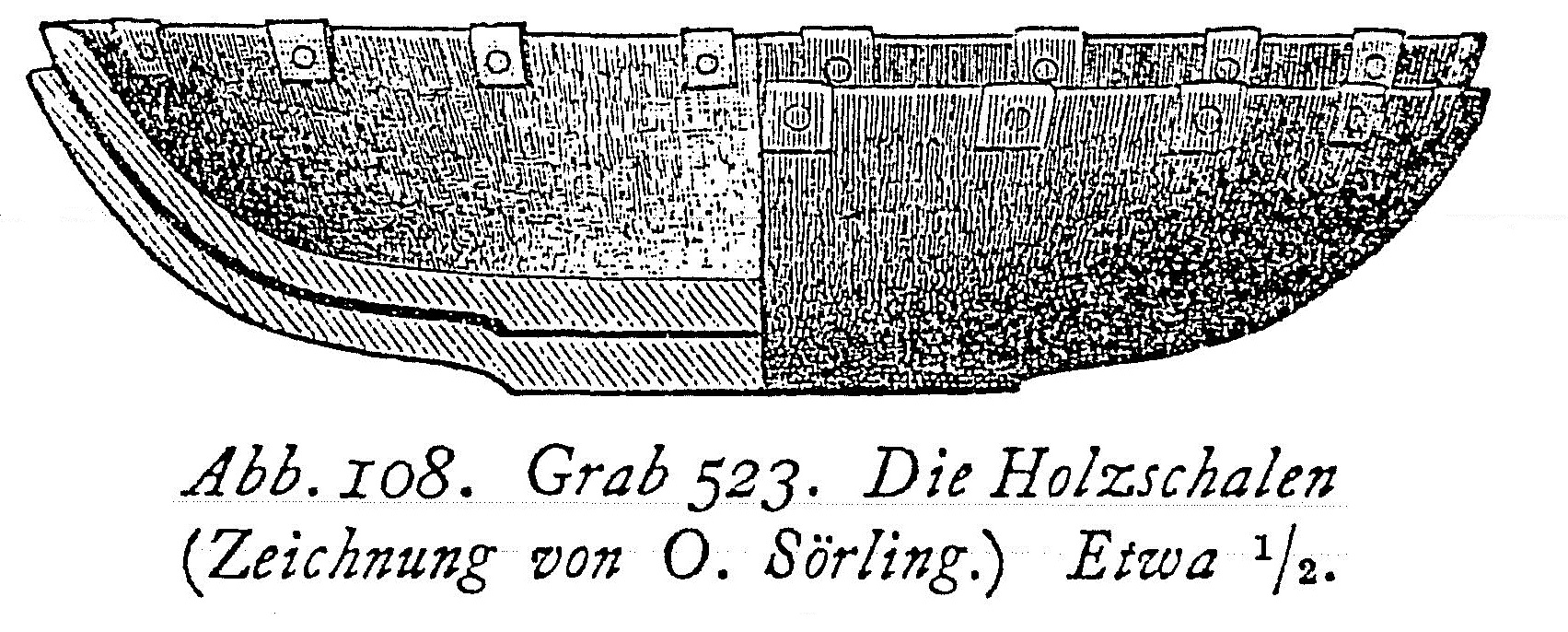This short overview is an amendment to the article Drinking Vessels of Viking Norway. It contains specimens of a specific type of lathed wooden cups, plates, bowls and buckets that has the brim reinforced or fixed with metal clasps or staples. From the distribution, it is clear such a tableware was quite popular in Early Medieval Northern, Central and Eastern Europe. They can be also compared with multipieced buckets and horns that are frequently covered in copper-alloy metals or silver. Metal edge clamps were popular in the older period as well (see for example Fingerlin 1964: 29; Koch 1977: 155; Koch 1990: 226; Koch 2001: 181; Korený et al. 2008; Paulsen 1992: 96-129; Pescheck 1996: Taf. 26.20, 57.8-9, 30.9-10, 62.12); Sippel 1989: 203).
Reconstructions of an Early Medieval bowl with silver fittings.
Václav Maňha, Dřevo krásné, dřevo mé.
Catalogue
In the catalogue, I will describe the known pieces from 9th – 11th century Europe. If there are some that are missing, let me know.
Haralds saga Sigurðarsonar 24
Let’s open the article with a literary mention that comes from Saga of Haraldr Sigurðarson. The saga mentions a noble gift – a bowl made of maple, with gilded silver rim and gilded silvered handle, full of silver coins:
“At the feast, king Haraldr gave Steigar-Þórir a maple bowl; it had a rim of silver and a silver handle, both gilded, and it was filled with burned silver pennies.” (Haraldr konungr gaf Steigarþóri at veizlunni mǫsurbolla; hann var gyrðr með silfri, ok silfrhadda yfir, ok gylt hvártveggja, ok fullr upp af skírum silfrpenningum).
Belarus
Grave 29, Navry, Belarus
A rectangular metal edge fitting of a wooden vessel was found in the grave in Navry cemetery, Belarus (Plavinski 2017: 55-6, Fig. 44.1). Under the fitting, the crack of the vessel and wire stitching is visible. The metal is not specified. Dating: 11th century.
Grave 22, Navasiolki, Belarus
Four wooden pieces from the adult male grave of Navasiolki bear traces of metal applications (Plavinski 2017: 55-6, Fig. 44.2-5). One of the fragments still shows a metal fitting attached. The metal is not specified. Dating: 11th century.

Grave 22, Navasiolki, Belarus. Plavinski 2017: Fig. 44.2-5.
Mound 10, Pahošča, Belarus
A bowl or cup with two copper alloy fittings were retrieved from the male mound 10 in the site of Pahošča (Plavinski 2017: 55, Fig. 43). The applications served as repairs. Both of them are rectangular in shape, one being a short, second being a longer. The shorter one is decorated by stamps, the longer one is undecorated. The cup is estimated to be 20 cm in diameter, 6 cm high. It had a short handle. The dating: late 10th or early 11th century.
Mound 10, Pahošča, Belarus. Plavinski 2017: Fig. 43.
Czech republic
Grave 309/49, Staré Město u Uherského Hradiště, Czech republic
Possible fragments of a lathed vessel were found in the grave 309/49 in Staré Město (Hrubý 1955: 460, Tab. 68). The vessel was decorated with found clamps and two crosses, all of them made of gilded copper alloy. Dating: Great Moravian horizon, 9th century. Copper alloy clamps from the grave no. 332, Rajhradice, Czech Republic (Staňa 2006: 72, Ob. 260) are probably of the same period, but the inner material is leather and it is therefore hard to speak about a vessel.

Fittings from Staré Město. Hrubý 1955: Tab. 68.
Graves 291/51 and 26, Staré Město u Uherského Hradiště, Czech republic
Two bottles from Staré Město – one found in the grave 291/51 (Staré Město – Na valách), second in the grave 26 (Špitálky) – were probably partially lathed (Dostál 1966: 86, Tab. XLIII.6-7; Hrubý 1955: 161, Obr. 25). The first mentioned bottle was ca. 20 cm high, 16 cm wide and was decorated with iron bands, a circular fitting between them and a mouth. The second piece was ornated with a copper alloy plate, held by an iron fitting. Dating: Great Moravian horizon, 9th century.

Bottles from Staré Město. Hrubý 1955: Obr. 25; Dostál 1966: Tab. XLIII.6-7.
Grave 24/57, Staré Město u Uherského Hradiště, Czech republic
The grave contains a fragment of a lathed cup with a small copper alloy hinge that holds a lid at place (Hochmanová-Vávrová 1962: 248, Tab. XI.10).
Grave 24/57, Staré Město u Uherského Hradiště. Hochmanová-Vávrová 1962: Tab. XI.10.
Graves 707/56 and 743/57, Dolní Věstonice, Czech Republic
Two U-shaped clamps from possible vessels are known from Dolní Věstonice (Ungerman 2007: 172; 2023: 322). The clamp from the grave 707/56 was made of copper alloy and is around 1 cm wide and 1,5 cm long. There are still 0,3 cm thick wooden traces inside and two rivets. The other one from the grave 743/57 is made of iron and is no longer preserved. A similar find – 3 clamps with traces of wood – is known also from a grave from Mikulčice-Panské, where the fittings created a circle. This find is unpublished.
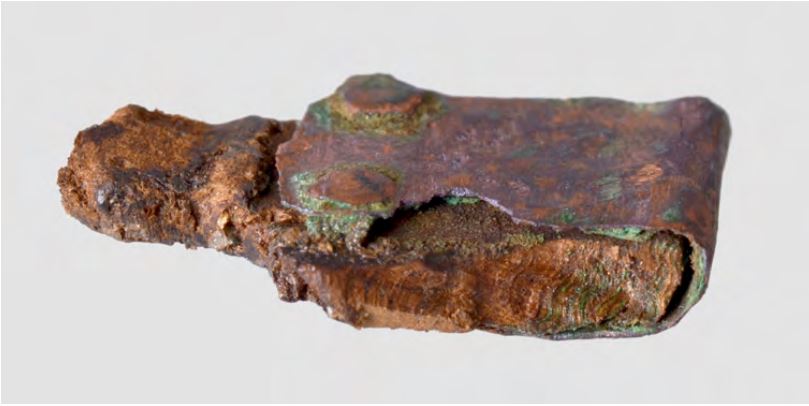

Grave 707/56, Dolní Věstonice. Ungerman 2023: 322, Tab. 184.3.
Grave ŽAP-41/2011, Žalov, Czech republic
The grave of an infant contained a bowl that was around 20 cm in diameter and was made of maple (Tomková et al. 2020: 132-3, Obr. 68-9). The edge of the bowl was decorated with at least 6 embossed fittings, probably made of tinned coper alloy. Another vessel is known from the grave 132, Kanín, Czech republic. The grave of an adult woman contained an 18 cm wide vessel that was decorated with copper-alloy fittings (Mařík 2009: 89, 131, Tab. 41.2-6). It is not possible to say whether it was lathed. The part of the vessel was a lid that fell apart. Dating points to 9th-10th century.

Grave ŽAP-41/2011, Žalov. Tomková et al. 2020: Obr. 68-9.
Finland
Grave 1/1888, Hovinsaaren Tontinmäki, Finland
For the sake of interest, we can mention a find from Karelia, where traditional material culture was preserved until the High Middle Ages. In grave 1/1888 from the site of Tontinmäki, the remains of a cracked juniper vessel were discovered that had been repaired using fittings (Schvindt 1893: 62, 150, 170, Fig. 89). There is an approximately square fitting on one side, and two rectangular fittings on the other side. All fittings and rivets are made of copper alloy. The grave is classified as female. Due to the burial items, the grave is dated to the 13th-14th century (Belskij 2013: 415).
The fragments of a vessel, grave 1/1888, Hovinsaaren Tontinmäki.
Schvindt 1893: Fig. 89.
Hungary
Grave 32, Tiszakürt ‒ Sziki-Kisföldek, Hungary
In 2019, Zágorhidi Czigány et al. published a brilliant article that shows a cracked bowl repaired with clasps and wire. The bowl was found in the grave 32 in Tiszakürt ‒ Sziki-Kisföldek, which is dated to 10th century. The another close analogy of wire stitching comes from tomb no. 20 in Dargavs, North Ossetia–Alania, Russia. An almost identical stitching was found in the grave 205 in Ždrijac u Ninu, Croatia (Belošević 2007: 168, Tab. LXXXVI).
The recontruction of the edge of the bowl, Grave 32, Tiszakürt ‒ Sziki-Kisföldek, Hungary.
Zágorhidi Czigány et al. 2019: 6. kép, 4-6.
The fragments of bowl, Grave 32, Tiszakürt ‒ Sziki-Kisföldek, Hungary.
Zágorhidi Czigány et al. 2019: 1. kép.
Latvia
Grave 30, Priekules Ģūģeru, Latvia
In 1988, a spectacular grave 30 was found in Latvian Priekules Ģūģeru. The grave, dated to 1st half of 11th century, contained a full warrior gear, textiles, trading equipment, jewellery and a cup (Apala – Zariņa 1991). The wooden cup has diameter of 100-120 mm and is 38 mm high. It is decorated with copper alloy plate that is 15 mm high (Apala – Zariņa 1991: 18, 5. att). The plate is continuous and goes all around the edge. The lower edge is toothed. The bowl seems to be repaired by wires.

The bowl from Priekules Ģūģeru. Apala – Zariņa 1991: 5. att, B.

Photo of the bowl, taken by Andrius Bitaitis.
Norway
Oseberg mound, Norway
One of the cups from Oseberg mound (C55000:97) is lathed of a piece of hard wood and the diameter is circa 100 mm (80 mm across the mouth); it is also reinforced with an iron band, that goes from inside to outside and is probably a patch (Grieg 1928: 196, Fig. 130). Dating: 1st half of the 9th century.

The complete cup from Oseberg mound. Source: Grieg 1928: Fig. 130, UNIMUS C55000:97.
Poland
Grave 60/00, Kałdus 4, Poland
Highly decorated metal elements of a plate were found in the male grave 60/00 from Kałdus 4, Poland (Chudziak 2010: 456-7, Tab. 14). The plate was made of maple wood. There were four tongue-shaped fittings bent around the edge plus a circular mount on the bottom. All the fitting were made of gilded copper alloy and decorated with zoomorfic ornaments. Dating: 11th century.

Grave 60/00, Kałdus 4, Poland. Chudziak 2010: Tab. 14.
Russia
C-306, Gnezdovo, Russia
A complete vessel – a small cup – decorated with silver clasps was found in the “female” grave C-306 (Avdusin – Puškina 1988: 23-4, Fig. 4.10). Based on the available drawing, we can say that the cup measured around 7 cm across the opening. The clasps were fastened with two rivets.
A vessel from the grave C-306 in Gnezdovo. Avdusin – Puškina 1988: Fig. 4.10.
Graves 7 and 74, Gnezdovo, Russia
According to Spitsyn (1905: 15), there were two fittings in the graves 7 and 74 (according to S. I. Sergeev). These fittings could come from a wooden vessel or a horn.
Grave II-1, Udraj, Russia
Ravdina (1988: 119-120, Табл. 11.13-14) informs a vessel that was decorated with four silver clamps and a equal-armed cross (2,8 × 3 cm big) from the grave II-1, Udraj. Based on the coins from the grave, 11th century dating can be suggested.

Fittings from Udraj. Ravdina 1988: Табл. 11.13-14.
Grave 10, Njubiniči, Russia
The grave 10 from Njubiniči revealed at leat 8 pieces of the vessel (Kočkurkina – Summanen 2021: 72, Рис. 96). There are at least 6 clamps and one square plate made of metal of green look, probably a copper alloy. The grave is dated to the turn of 10th-11th century.
Grave 10, Njubiniči, Russia. Kočkurkina – Summanen 2021: Рис. 96.
Chamber grave 1, Pskov, Russia
Inside the chamber grave 2 in Pskov, a long silver clamp was found. It is interpreted as a fitting coming from a vessel (Yakovleva 2015: 70, Cat. no. 25). The clamp is decorated with punched decoration and contains wood inside.
Yakovleva 2015: 70, Cat. no. 25.
Chamber grave 6, Pskov, Russia
A metal rim of a turned cup was found in the looted male chamber grave 6 from Pskov (Eršova 2015a: 268, Рис. 20). The rim has an outer diameter of 13.8 cm, a height of 0.6-0.7 cm, a width of 0.6 cm and is made of 0.05 cm thick silver metal sheet. The total weight of the silver residue is 35.41 g. The 8.7 cm wide by 3.5 cm long handle was made from a separate piece that was soldered to the rim. The handle is decorated with niello. The grave is dated to the 3rd quarter of the 10th century after 953/4.
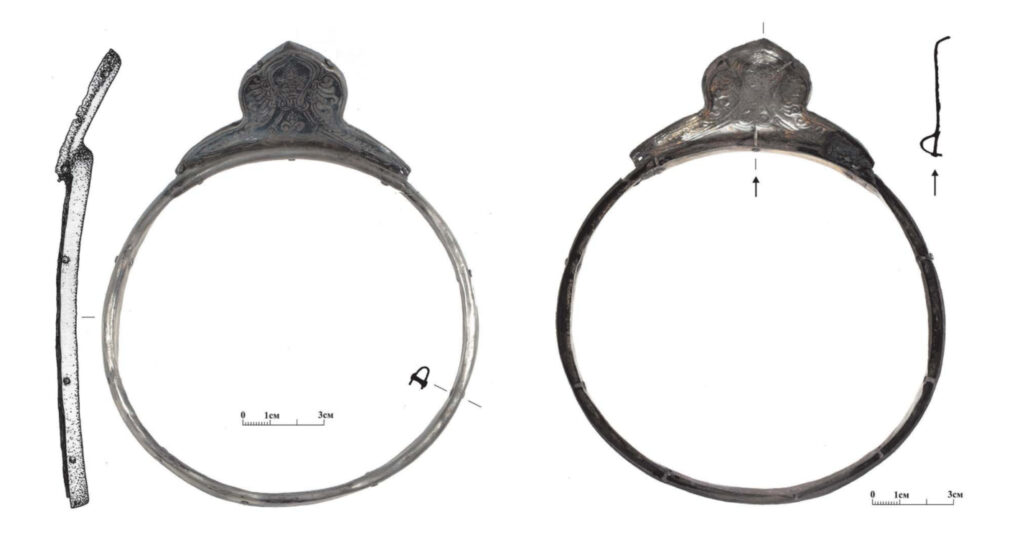
Cup fragments from Chamber grave 6. Eršova 2015a: Каталог 3.
Chamber grave 7, Pskov, Russia
Northwestward of the coffin of the girl in Pskov chamber grave 7, there were objects interpreted as fragments of a wooden bowl (Eršova 2015b: 322, Рис. 17, Каталог 6). The diameter of the bowl is described to be 9 cm. There are no preserved wood in the burial. The metal elements consist of 5 gilded silver sub-triangular clasps, fragments of silver narrow strip clasps, a square silver-plated fitting (size 22 × 22 mm) with a round hole in the center (8 mm in diameter) and an irregular semicircular plate with raised sides along the edge, decorated with floral ornaments in niello, probably a handle cover.

Fragments of a bowl from Chamber grave 7, Pskov. Eršova 2015b: Каталог 6.
An X-ray of the bown in situ. Eršova 2015b: 322, Рис. 17.
Graves 100, 118, 285, 457, Timerevo, Russia
Fechner and Nedoshivina (1987: 74) inform that bronze mounts from vessels were found in four graves of Timerevo – 100, 118, 285, 457. Unfortunately, I was not able to find further details on these finds.
Grave 459, Timerevo, Russia
The grave 459 in Timerevo contained fragments of a wooden vessel that was decorated with simple metal clasps along the brim (Fechner – Nedoshivina 1987: 74-5, Рис. 6.2-6). At the bottom of the vessel, there was a circular fitting, fastened with 7 rivets. The circular fitting was inscribed. The closest analogy of the vessel is Bj 11A in Birka.
Remnants of a vessel from grave 459, Timerevo. Fechner – Nedoshivina 1987: Рис. 6.2-6.
Catacomb 5, Dargavs burial ground, Russia
The catacomb no. 5 in Dargavs cemetedy revealed a wooden vessel with a decorated edge and handle (Uspenskij – Albegova 2021: 112, 247, Рис. 110.6). The material of the metal is not known to the author. The dating points to mid 10th – 11th century.
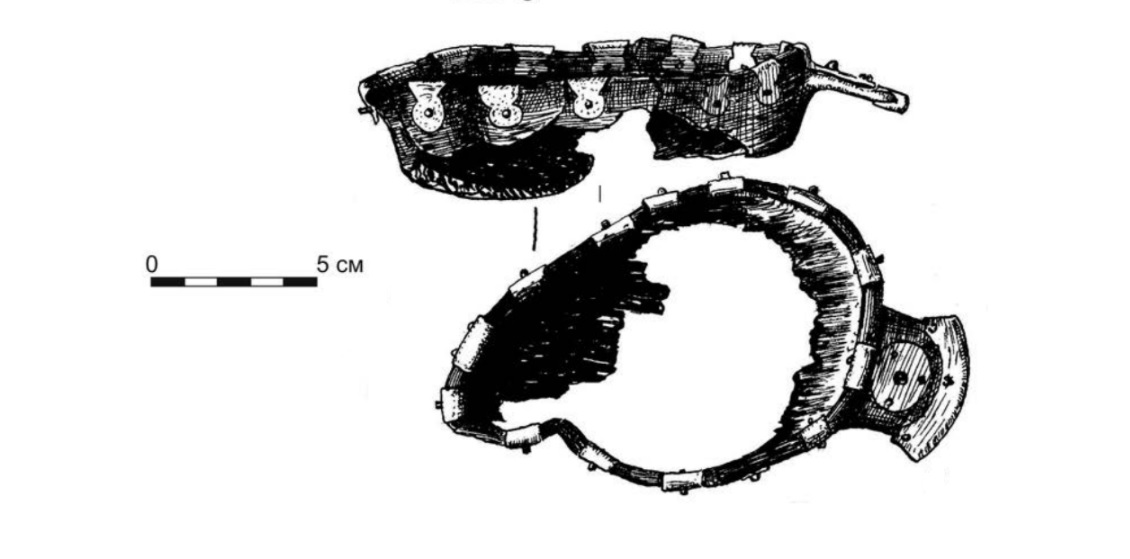
Catacomb 5, Dargavs burial ground, Russia. Uspenskij – Albegova 2021: Рис. 110.6.
Catacomb 76, Dargavs burial ground, Russia
The catacomb no. 76 in Dargavs cemetedy revealed a wooden vessel with a decorated edge and circular fitting at the bottom of the bowl (Uspenskij – Albegova 2021: 238, Рис. 100.6). The material of the metal is not known to the author. The dating points to mid 8th – 9th century.

Catacomb 76, Dargavs burial ground, Russia. Uspenskij – Albegova 2021: Рис. 100.6.
Sweden
Bj 11A, Birka, Sweden
The grave Bj 11 revealed silver mounts that could originate from a wooden vessel or a plate (Arbman 1940: Taf. 216.13; Arbman 1943: 2-4, Abb. 108; Lindeberg 1984: 243). The mounts were found around a clay vessel that was used as an urn. As the clay vessel was quite big, circa 18 cm in diameter, the only way how mounts could be found all around the vessel is the presumption that the wooden vessel was quite wide and open and was placed under or on top of the urn. The most prominent mount is a circular fitting, 2 cm wide, fastened with 4 rivets and decorated with circles. There are also at least 7 silver clasps (size 13 × 11 mm), some decorated with punched circles, fastened with 2-3 rivets. Their profile suggests they truly come from a wooden dish.
Silver fittings of a vessel from Bj 11A, Birka. Arbman 1940: Taf. 216.13.
Bj 507, Birka, Sweden
A lathed, metal-decorated bucket was found in the “female” grave Bj 507 (Arbman 1940: Taf. 203-4; Arbman 1943: 148; Bakka 1984). It is made of thin birch wood, 18,3 cm high, 17,8-19,5 cm wide at the mouth and 12,6 cm at the bottom. The whole surface was covered with decorated copper alloy bands. It definitely comes from British Isles.

The bucket from Bj 507, Birka. Arbman 1940: Taf. 203-4, catalog SHM.
Bj 523, Birka, Sweden
In the “female” grave Bj 523, two identical vessels were found, from which only one was reasonably preserved, though also badly damaged (Arbman 1940: Taf. 214; Arbman 1943: 157-160, Abb. 108; Lindeberg 1984: 242). The bowls were put together. The thickness of the wood was 4 mm. The outer side of better preserved bowl carried turning traces. The edge is covered with U-shaped square silver clamps of the size 7 × 7 mm at interval of 15 mm. Clamps are fastened by single rivets. The current diameter of the bowl is 112 mm. One of the vessels had a short horizontal handle at the level of the edge. The handle was decorated with a shield-shaped fitting of the size 24 × 15 mm, which was fastened with four rivets.
Remains of the vessels from Bj 523. Arbman 1940: Taf. 214.
Drawn reconstruction of the vessels from Bj 523, Birka. Arbman 1943: Abb. 108.
The drawing does not reflect the presence of a short handle.
Bj 544, Birka, Sweden
Badly damaged fragments of a wooden vessel were found in the “male” grave Bj 544 (Arbman 1940: Taf. 215.3; Arbman 1943: 170-1; Lindeberg 1984: 242-3). Based on the description by Arbman (1943: 171), we can guess the vessel had a short triangle horizontal handle at the level of the edge (similar to what we know from Årby and Haithabu). The thickness of the wood was 4 mm. The outer side of the vessel carries turning traces. The edge of the vessel was decorated with a fitting made of silver, size 19 × 17 mm. The fitting is riveted by two riveted and is decorated with punched triangles and lines of dots.
Remains of the vessel from Bj 544, Birka. Arbman 1940: Taf. 215.3.
Bj 711A, Birka, Sweden
In the grave Bj 711A, a copper alloy fitting of a small vessel was found (Arbman 1940: Taf. 216.5; Arbman 1943: 246; Lindeberg 1984: 243). Arbman notes the wood was still preserved at the time of the excavation. The edge of vessel is 5 mm thick and profiled. The fitting measures 32 × 28 mm and is not complete. The fitting was attached with two rivets. The sex of the deceased person in the grave is not known.
Copper alloy fitting from Bj 711A, Birka. Arbman 1940: Taf. 216.5.
Bj 885, Birka, Sweden
The vessel from Bj 885 was decorated with four copper alloy clasps (Arbman 1943: 344; Lindeberg 1984: 242-3). Today, nothing but rivets can be seen. The sex of the deceased person in the grave is not known.
Bj 886, Birka, Sweden
In the “male” grave Bj 866, fragments of a stunning vessel was found (Arbman 1940: Taf. 216.7-12; Arbman 1943: 344-6; Lindeberg 1984: 242). What we know about the vessel is that it was more than 5 cm high, 7 mm thick and it had a small horizontal handle. The handle was covered with an oval mount (original size about 33 × 12 mm) with pressed ornament . The mount was riveted to the handle with three rows of rivets. At least 4 clasps are riveted to the profiled edge; the complete fittings measures 16 × 21 mm and are fastened by two rows of rivets. Two clasps are decorated with nothing but lines, the other two are decorated with pressed decoration that is similat to handle mount. The pressed clasps are decorated with pearl edges too. There is one more fitting, 5 cm long sheet which is a repair of a broken edge of the vessel. The sheet is riveted with three rows of rivets.
The material for the handle mount and clasps is gilded silver. Rivets used for this mounts are made of copper alloy and their heads are waved. The repair sheet is said to be silver riveted with undecorated copper alloy pins.
Fragments of a vessel from Bj 886, Birka. Arbman 1940: Taf. 216.7-12.
Bj 964, Birka, Sweden
A copper alloy fitting of a vessel was found in the “female” burial Bj 964 (Arbman 1940: Taf. 216.4; Arbman 1943: 389; Lindeberg 1984: 242-3). Arbman notes the wood was still preserved at the time of the excavation. The edge of vessel is 5 mm thick and profiled. The fitting measures 36 × 15 mm and was attached with four rivets.
Fragments of a vessel from Bj 964, Birka. Arbman 1940: Taf. 216.4.
Bj 987, Birka, Sweden
Two copper alloy fittings of a vessel were found in the “female” burial Bj 987 (Arbman 1940: Taf. 216.6; Arbman 1943: 413-5; Lindeberg 1984: 242-3). The fittings measure 13 × 27 mm and were fastened with 4 rivets. There are decorating border lines around the fittings. The edge was of the vessel was 4 mm thick.
Fragments of a vessel from Bj 987, Birka. Arbman 1940: Taf. 216.6.
Grötlingbo, Gotland, Sweden
The grave (SHM 28043) contained a part of a wooden vessel made of birch (Thunmark-Nylén 1998: Taf. 276.4; Trotzig 1991: 242-5, Pl. 23 d:6). The bowl is estimated to be around 14-15 cm in diameter and it was equipped with a silver double-sided mount held by 5 silver rivets. Size of the silver mount: 3×3,4 cm.

The fragment from Grötlingbo. Thunmark-Nylén 1998: Taf. 276.4; Trotzig 1991: Pl. 23 d:6.
Grave 2, Tibble, Sweden
In skeletal grave 2 from the site of Tibble, discovered in 1944, the remains of a wooden vessel with two mouth fittings were found. These fittings, made of a copper alloy, were taller on the outside of the vessel than on the inside. The fittings were attached with an unspecified number of copper alloy rivets (Serning 1966: 79, 146, Pl. 13.7-8).


The fragments from Tibble. Serning 1966: Pl. 13.7-8.
Grave from Hammarby, Sweden
In one of the coffin graves from the site of Hammarby, band-shaped copper alloy fitting originating from an outer side of a wooden vessel were found. The grave is dated to the 11th or early 12th century (Gezelius 1959: 208).
Ukraine
Grave 118, Kyiv, Ukraine
In the looted mound discovered in 1899, which was a double grave, among other things, a turned vessel with a mouth diameter of 14 cm was found (Karger 1958: 194, рис. 38), a close anbalogy to the find from the chamber grave 6 of Pskov. This vessel had a short handle that was covered with a silver hammered sheet. This part was subsequently covered with a longer silver band, which was bent around the entire mouth of the vessel. The riveting was done with silver rivets. Dating: 10th century.

Metal fitting from the grave 118 of Kyiv. Karger 1958: рис. 38.
2 Velyka Zhytomyrska Street, Kyiv, Ukraine
During the excavation at 2 Velyka Zhytomyrska in Kyiv, the historical center of the city, heart-shaped silver mounts from a vessel were found (Borovskij et al. 1989). The find was excavated by Ya. E. Borovsky in 1988 and can be dated to 10th century.

Metal fittings from 2 Velyka Zhytomyrska Street, Kyiv. Borovskij et al. 1989: Рис. 37.

A reproduction of the find from Kyiv. Made by Oleksii Malev.
United Kingdom
York
A lathed maple bowl with a diameter of 19.3 cm, a height of 4.6 cm and a thickness of 0.6 cm is cracked on the edge and fixed with a clamp made of tin, lead and zinc alloy (Morris 2000: 2402, Figs. 1019, 1041). The clamp is held in place by two rivets. The crack was apparently originally repaired with a different staple, which was later replaced. We know several other bowls from York that are fixed with staples.

The bowl from York. Source: Morris 2000: Figs. 1019, 1041; Kyriacou et al. 2004: 15.
I hope you liked reading this article. If you have any question or remark, please contact me or leave a comment below. If you want to learn more and support my work, please, fund my project on Patreon or Paypal.
Bibliography
Saga of Haraldr Sigurðarson (Haralds saga Sigurðarsonar) = Haralds saga Sigurðarsonar. Edited by N. Linder an H. A. Haggson. In: Heimskringla Snorra Sturlusonar III, Uppsala 1872. Online.
Apala, Z. – Zariņa, A. (1991). Dižciltīga latgaļa apbedījums Ģūģeru kapulaukā. In: Latvijas Vēstures Institūta Žurnāls, Nr. 1, 11-29.
Arbman, Holger (1940–1943). Birka I. Die Gräber. Text (1943), Tafeln (1940), Stockholm.
Avdusin, D. A. – Puškina, T. A. (1988). Three Chamber Graves at Gniozdovo. (Tre kammergraver fra Gniozdovo). In: Fornvännen 83, Stockholm, 20-33.
Bakka, Egil (1984). Der Holzeimer aus Bj 507. In: Arwidsson, Greta (Ed.). Birka II:1. Systematische Analysen der Gräberfunde, Stockholm, 232–235.
Belošević, Janko (2007). Starohrvatsko groblje na Ždrijacu u Ninu, Zadar.
Belskij 2013 = Бельский, С. В. (2013). Погребальные памятники Карельского перешейка и Северного Приладожья XI–XV вв. (хронология вещевых комплексов), Санкт-Петербург.
Dostál, Bořivoj (1966). Slovanská pohřebiště ze střední doby hradištní na Moravě, Praha.
Eršova 2015a = Ершова, Т. Е. (2015). Камерное погребение 6 // Древнерусский некрополь Пскова X – начала XI в.: В 2 т. Т. 2. Камерные погребения древнего Пскова X в. (по материалам археологических раскопок 2003 – 2009 гг. у Старовознесенского монастыря), СПб., 257–308.
Eršova 2015b = Ершова, Т. Е. (2015). Камерное погребение 7 // Древнерусский некрополь Пскова X – начала XI в.: В 2 т. Т. 2. Камерные погребения древнего Пскова X в. (по материалам археологических раскопок 2003 – 2009 гг. у Старовознесенского монастыря), СПб., 309–346.
Fechner – Nedoshivina 1987 = Фехнер, М.В. – Недошивина, Н. Г. (1987) Этнокультурная характеристика Тимеревского могильника по материалам погребального инвентаря // СА 1987, 2, 70-89.
Fingerlin, Gerhard (1964). Grab einer adeligen Frau aus Güttingen (Ldkrs. Konstanz), Freiburg.
Hrubý, Vilém (1955). Staré Město. Velkomoravské pohřebiště „Na Valách“. Monumenta Archaeologica III, Praha.
Hochmanová-Vávrová, Věra (1962). Velkomoravské pohřebiště ve Starém Městě „Na valách“. Výzkum v letech 1957–1959. In: ČMMZ, vědy společenské XLVII, 201–270.
Gezelius, Lars (1959). Hammarbyskon – ett uppländskt gravfynd. In: TOR – Meddelanden från Uppsala universitets museum för nordiska fornsaker 5, 205-219.
Grieg, Sigurd (1928). Osebergfunnet II : Kongsgaarden, Oslo.
Chudziak, Wojciech (red.) (2010). Wczesnośredniowieczne cmentarzysko szkieletowe w Kałdusie (stanowisko 4), MSL 5, Toruń.
Karger 1958 = Каргер, М. К. (1958). Древний Киев. Очерки по истории материальной культуры древнерусского города. Том 1, Москва – Ленинград.
Kočkurkina – Summanen 2021 = Кочкуркина, С. И. – Сумманен, И. М. (2021). Средневековые древности. Каталог археологических коллекций ИЯЛИ КарНЦ РАН, Петрозаводск.
Koch, Ursula (1977). Das Reihengräberfeld bei Schretzheim, Teil I-II, Berlin.
Koch, Ursula (1990). Das fränkische Gräberfeld von Klepsau im Hohenlohekreis, Stuttgart.
Koch, Ursula (2001). Das alamannisch-fränkische Gräberfeld bei Pleidelsheim, Stuttgart.
Korený, Rastislav et al. (2008). Dřevěné nádoby z mladšího stupně doby stěhování národů v Čechách. In: Archeologie ve středních Čechách 12, 601–618.
Kyriacou, Christine et al. (2004). Treasures of York, Ashbourne.
Lindeberg, Inga (1984). Holzschalen, Holzdosen und Beschläge zu derartigen Holzobjekten. In: Arwidsson, Greta (Ed.). Birka II:1. Systematische Analysen der Gräberfunde, Stockholm, 242–244.
Paulsen, Peter (1992). Die Holzfunde aus dem Gräberfeld bei Oberflacht und ihre kulturhistorische Bedeutung, Stuttgart.
Pescheck, Christian (1996). Das fränkische Reihengräberfeld von Kleinlangheim, Lkr. Kitzingen/Nordbayern, Mainz.
Plavinski 2017 = Плавінскі, Мікалай (2017). Курганны могільнік Пагошча ў кантэксце сінхронных старажытнасцяў Браслаўскага Паазер’я, Мінск.
Mařík, Jan (2009). Libická sídelní aglomerace a její zázemí v raném středověku, Praha.
Morris, C. A. (2000). Wood and woodworking in Anglo-Scandinavian and Medieval York, The Archaeology of York 17/13, York.
Ravdina 1988 = Равдина, Т. В. (1988). Погребения X-XI вв. с монетами на территории Древней Руси. Каталог, Москва.
Serning, Inga (1966). Dalarnas järnålder, Stockholm.
Schvindt, Theodor (1893). Tietoja Karjalan rautakaudesta ja sitä seuraavilta ajoilta Käkisalmen kihlakunnan alalta saatujen löytöjen mukaan, Helsingissä.
Sippel, Klaus (1989). Die frühmittelalterlichen Grabfunde in Nordhessen, Wiesbaden.
Spitsyn 1905 = Спицын, А. А. (1905). Гнездовские курганы из раскопок С.И. Сергеева // ИАК 15, 6-74.
Staňa, Čeněk (2006). Velkomoravská pohřebiště v Rajhradě a Rajhradicích, Brno.
Thunmark-Nylén, Lena (1998). Die Wikingerzeit Gotlands II : Typentafeln, Stockholm.
Tomková, Kateřina et al. (2020). Levý Hradec v zrcadle archeologických výzkumů. Pohřebiště, díl II, Praha.
Trotzig, Gustaf (1991). Craftsmanship and function : A study of metal vessels found in Viking Age tombs on the island of Gotland, Sweden.
Yakovleva 2015 = Яковлева, Е. А. Камерное погребение 1 // Древнерусский некрополь Пскова X – начала XI в.: В 2 т. Т. 2. Камерные погребения древнего Пскова X в. (по материалам археологических раскопок 2003 – 2009 гг. у Старовознесенского монастыря), СПб., 2015, стр. 28–83.
Ungerman, Šimon (2007). Raně středověké pohřebiště v Dolních Věstonicích – Na Pískách, Brno : Masarykova univerzita.
Ungerman, Šimon (2023). Raně středověké pohřebiště v Dolních Věstonicích – Na pískách. Díl I – Analýza, Díl II – Katalog, Brno.
Uspenskij – Albegova 2021 = Успенский, П. С. – Албегова (Царикаева), З. Х. (2021). Древности Центрального Кавказа VII-XIII вв. (по материалам Даргавского могильника), Москва.
Zágorhidi Czigány, Bertalan ‒ Kenéz, Árpád ‒ Türk, Attila (2019). Tiszakürt‒Sziki-Kisföldek 32. objektum honfoglalás kori sír. Adatok a 10. századi hurkos végű bronzdrótok érékeléséhez, valamint a lovaglóostorok és fémszerelékes faedények elkülönítéséhez a korszak hagyatékában. In: „Hadak útján” A népvándorláskor fiatal kutatóinak XXIX. konferenciája – 29th Conference of Young Scholars on the Migration Period, Budapest, 59-67.
Decorated vessels made by Dmitry Hramtsov (Truin Stenja).









